If your car’s clear coat is looking a little dull, you may be wondering if you need to take it in for a pricey paint job. Before you shell out cash for something you probably don’t need, try using a rubbing compound on the clear coat first. Rubbing compounds can help remove scratches and blemishes, as well as give your car’s finish a nice shine.
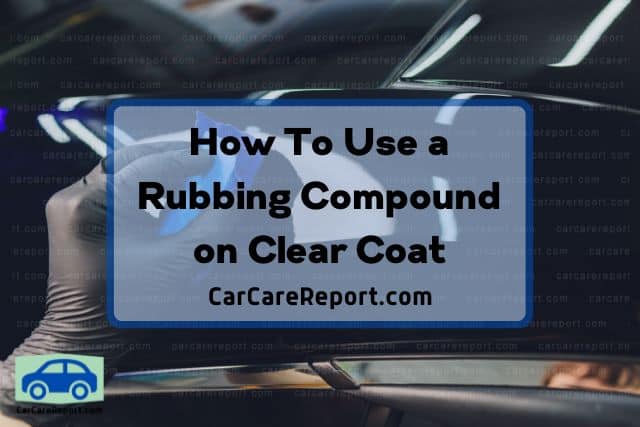
Here’s how to use a rubbing compound on a clear coat in 9 easy steps:
- Assess the level of scratching.
- Wash and dry your vehicle.
- Apply rubbing compound to a clean, dry cloth.
- Wipe the cloth over the areas with scratches.
- Apply more compound if needed.
- Wipe off the excess compound.
- Buff the area with a polishing pad.
- Wax your vehicle.
- Assess the results.
This article will show you how to use a rubbing compound on a clear coat to achieve a shiny finish that looks good as new. Read on for a rundown of these steps and the precautions you should take while using a rubbing compound.
1. Assess the Level of Scratching
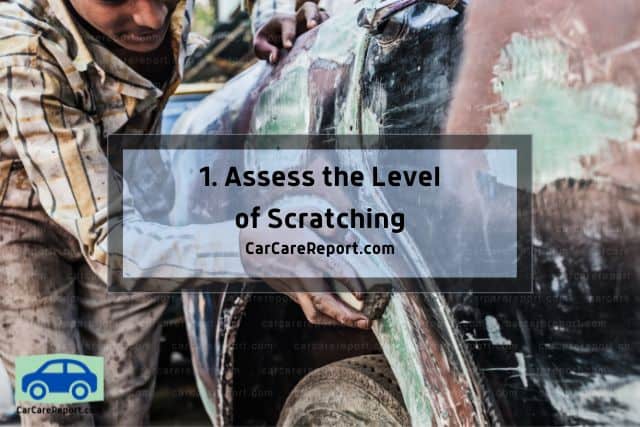
When using a rubbing compound, assess the level of scratching on your car’s finish first. If the scratches are only superficial, you likely won’t need a rubbing compound. Instead, a polishing compound may be enough.
Here are a few tips to assess the level of scratching:
- Use your fingernail to feel the scratch. If your fingernail catches on the scratch, it’s likely deep and will require rubbing compound to remove. If the scratch doesn’t catch on your fingernail or feels smooth, it’s probably only superficial, and a polishing compound will suffice.
- Look at it in direct sunlight. If you can see indentations in the paint or metal, the scratch is deep. Superficial scratches will be less noticeable in direct sunlight since they don’t go below the top layer of paint.
Assessing the level of scratching before using a rubbing compound will save you time and effort in the long run. By knowing which type of compound to use from the start, you’ll be one step closer to a perfect finish.
Tip: For the best results, use this Meguiar’s Clear Coat Safe Rubbing Compound. It’s gentle enough to use on clear coats without causing any damage, making it perfect for this project.
2. Wash and Dry Your Vehicle
After you’ve determined your car’s finish needs work, it’s time to wash and dry the vehicle. That’ll remove any dirt or debris that could get in the way while using the rubbing compound. Otherwise, you might make the scratches worse by rubbing in the debris along with your cleaning solution.
To properly wash and dry your vehicle, you’ll need:
- A bucket
- A hose with a spray nozzle. Go with this option rather than a pressure washer, which can be too hard on your vehicle and cause further damage.
- A soft sponge or washcloth
- A microfiber cloth
- A sponge or cloth
- A clean, dry towel
- Car shampoo. I recommend this 3D Wash N Wax Car Wash Soap. It’s a quality product with features like a built-in wax formula to give your car’s paint a nice shine and a high foaming action that’ll quickly remove dirt and grime.
To wash your car, follow these steps:
- Rinse your vehicle off with a hose.
- Fill a bucket with water and car shampoo. Mix it around until the water is sudsy.
- Dip your sponge or cloth into the soapy water and then wash your car’s surface, taking care not to miss any spots.
- Rinse your car off with the hose again.
- Dry your car with a clean, dry towel.
Note: Make sure to go over the entire surface so there’s no water left behind.
3. Apply Rubbing Compound to a Clean, Dry Cloth
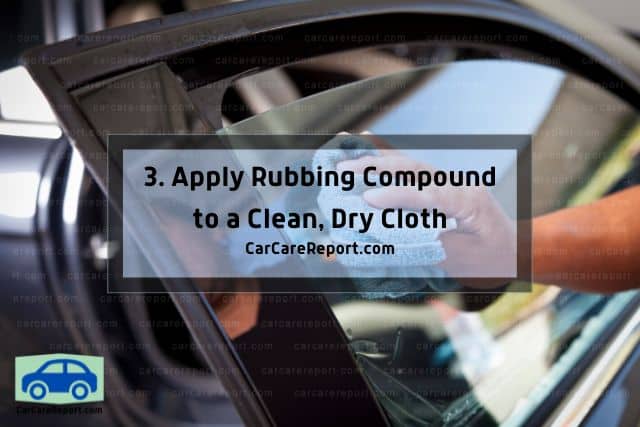
Now that your car is clean and dry, it’s time to apply the rubbing compound.
First, pour a small amount of compound onto a clean, dry cloth. For the best results, ensure the cloth is made of a soft material like cotton. You don’t want to try to remove the scratches, only to add even more.
Here are a few tips for choosing the right cloth:
- Look for a soft cloth that won’t scratch the surface.
- Avoid using a paper towel since it may fall apart and leave debris behind.
- Ensure the cloth is clean and free of dirt or debris.
- Cotton is a good choice since it’s soft and absorbent.
Caution: Ensure you wear gloves before handling the rubbing compound. The compound is abrasive and can be harmful if it comes into contact with your skin.
4. Wipe the Cloth Over the Areas With Scratches
Once the cloth is saturated with rubbing compound, wipe it over the areas with scratches. Be sure to apply enough pressure to work the compound into the scratches.
You may need to go over the same area several times to remove the scratches fully.
Here are a few other tips for applying rubbing compound:
- Wipe the cloth over the surface in small, circular motions.
- Work one small area at a time. That’ll help you avoid missing any spots and ensure that the compound is evenly applied.
- If the cloth starts to dry out, add more compound.
5. Apply More Compound if Needed

If the cloth starts to dry out or the scratches don’t seem to be budging, add more compound to the cloth. Continue wiping the cloth over the surface until the scratches are gone. Again, remember to work in small sections so the compound doesn’t dry out too quickly.
6. Wipe Off the Excess Compound
After you’ve gone over the entire surface and removed all of the scratches, it’s time to wipe off the excess compound. To do that, follow these steps:
- Use a clean, dry towel to remove any residue.
- Be sure to go over the entire surface, including the hard-to-reach areas. Otherwise, the compound could dry and leave behind a dull finish.
7. Buff the Area With a Polishing Pad
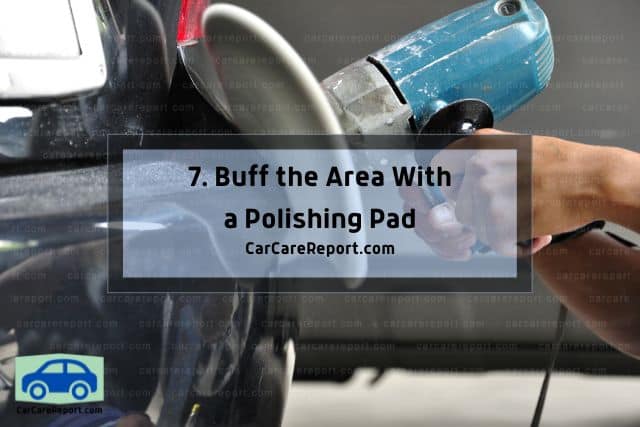
Once all of the compound has been removed, buff the area with a polishing pad. That’ll help restore the shine to your car’s finish.
To buff the area, follow these steps:
- Attach the polishing pad to a drill.
- Apply the pad to the surface and turn on the drill.
- Buff the area in a circular motion.
- Continue buffing until you’re happy with the results.
Caution: Don’t apply too much pressure while buffing. Otherwise, you could damage the surface of your car.
8. Wax Your Vehicle
After using a rubbing compound to remove the scratches, you need to protect the newly-buffed area by waxing your vehicle. Wax creates a barrier between the elements and your car’s finish, prevents future scratches, and keeps your car’s surface looking shiny and new.
To wax your car, follow these steps:
- Apply a small amount of wax to a clean cloth.
- Wipe the cloth over the surface in small, circular motions.
- Be sure to go over the entire surface, including the hard-to-reach areas.
- Allow the wax to dry, and then buff the area with a clean cloth.
9. Assess the Results
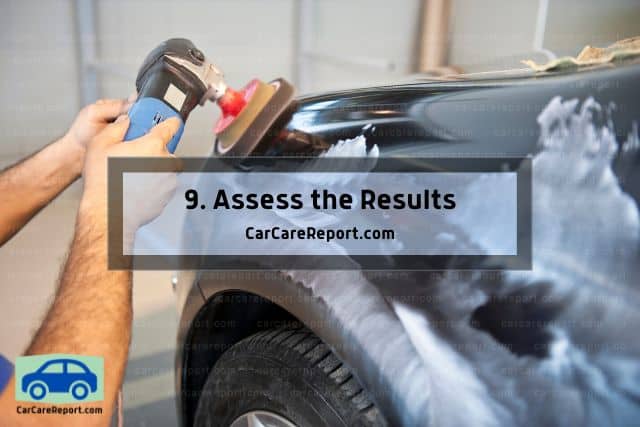
Once you’ve followed all of the steps, take a step back and assess the results. If you’re happy with how your car looks, you’re done!
If there are still a few scratches remaining, you may need to repeat the process. Just be sure to take your time and be careful not to miss any spots.
Here are a few ways to tell if you need to repeat the process:
- If there are still some scratches remaining, you’ll need to go over the area again.
- If the area looks dull or hazy, you may have applied too much pressure while buffing. In that case, you’ll need to start over.
- If you’re not happy with the results, don’t hesitate to try again. With a little practice, you’ll be able to remove the scratches and restore your car’s finish in no time!
Precautions To Take When Using a Rubbing Compound

While rubbing compounds effectively remove scratches, there are a few things you need to keep in mind to avoid damaging your car’s surface.
Here are a few precautions to take when using rubbing compound on clear coat:
Read the Instructions Before Using the Compound
Most people have heard of rubbing compound, even if they don’t know exactly what it is. Rubbing compound is a type of polish used to clean and protect surfaces. You can use it on everything from countertops to car paint. When used correctly, a rubbing compound can help keep surfaces looking new.
However, it’s important to read the instructions before using the compound. That way, you’ll know how to apply it correctly and what precautions to take.
If you’re not sure how to use the rubbing compound, don’t hesitate to ask someone who does. With a little care and attention, you can keep your vehicle looking good for years to come.
Test the Compound on an Inconspicuous Area First
Before using any compound or solution on your car’s surface, it’s always good to test it on an inconspicuous area first. By doing this, you can get an idea of how the solution will work without risking damage to the more visible areas of your car.
If you’re not sure where to test the solution, choose an area that’s out of the way like the trunk. That way, even if there is some damage, it won’t be as noticeable.
Remember, it’s always better to be safe than sorry. So take a few minutes to test the solution before using it on your entire car.
Use a Clean Cloth
Applying a scratch-repair compound is an important step in keeping your car’s paint job looking good as new. However, you need to use a clean cloth when applying the compound. Otherwise, you could put dirt and other debris on your car’s surface, which could cause more scratches.
Also, a clean cloth will help to ensure that the compound is evenly applied. By taking the time to use a clean cloth, your car’s paint job will continue to look its best.
Choose the Right Type of Compound
There are a few different types of rubbing compounds, so it’s important to choose the right one for your needs. If you’re not sure which one to use, ask someone at the store for help.
CarCareReport dot com is owner of this article and was first posted on Sep 21, 2022 and was updated on ..
There are two types of rubbing compounds: abrasive and non-abrasive. Abrasive compounds are more aggressive and are typically used to remove heavy scratches. Non-abrasive compounds, on the other hand, are less likely to damage the surface and are better for light scratches.
So, depending on the type of scratch you’re trying to repair, you need to choose the right compound. Otherwise, you could end up doing more harm than good.
Use the Right Amount of Compound
When using a rubbing compound, it’s important to use the right amount. If you use too much, you could end up damaging the surface. On the other hand, if you don’t use enough, the compound won’t be effective. So, how much compound should you use?
For light scratches, you’ll only need to use a small amount of compound. However, you’ll need to use a larger amount for more serious scratches.
To be safe, it’s always best to start with a small amount of compound and then add more as needed. That way, you can avoid using too much and damaging the surface of your car.
Rub the Compound in a Circular Motion
When rubbing the compound into the surface, use a circular motion. By rubbing in a small circle, you can help to avoid streaks and ensure that the compound is evenly applied. In addition, using a circular motion will help to avoid damaging the surface.
So, take your time and rub the compound in a gentle, circular motion.
Avoid Using Rubbing Compound in Direct Sunlight
When using a rubbing compound, remember to avoid using it in direct sunlight. The sun’s rays can cause the compound to dry too quickly, making it difficult to apply. In addition, the heat from the sun can cause the compound to become too hot, which could damage the surface.
So, if possible, apply the compound in the shade or an area out of direct sunlight.
Wrap Up
Using a rubbing compound is vital to keeping your car’s paint job looking its best. However, it’s important to use the right type of compound and apply it correctly. By following the steps above, you can help to ensure your car’s paint job looks its best for years to come.
First published on Sep 21, 2022 by CarCareReport.com.
Remember, it’s always better to be safe than sorry. So take your time and be careful when using a rubbing compound. With a little time and effort, you can keep your car’s paint job looking its best. Happy polishing!
Related Articles
How To Clean a Car Interior With Household Products
How To Hand Wash a Car Faster (Tips and Tricks)
How To Detail a Car That Has Ceramic Coating
Shampoo vs. Steam Clean: Which is Better for a Car?
CarCareReport dot com first published this article on Sep 21, 2022..
